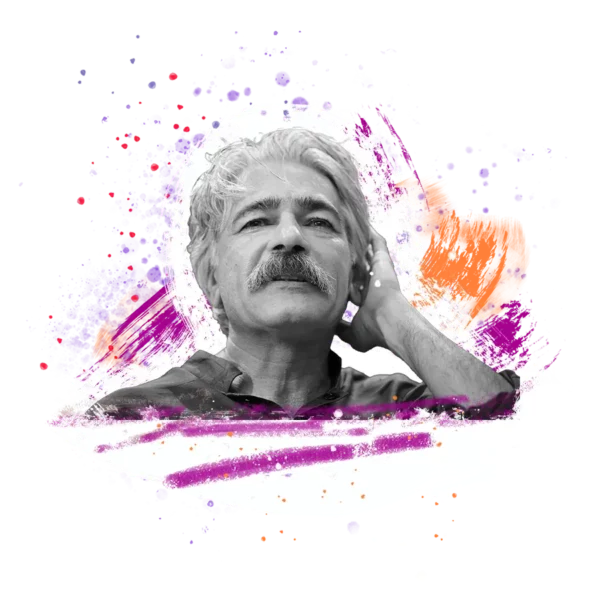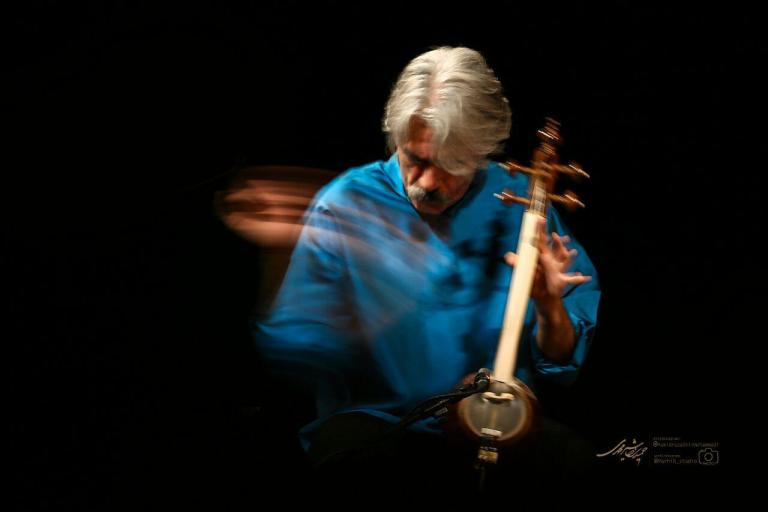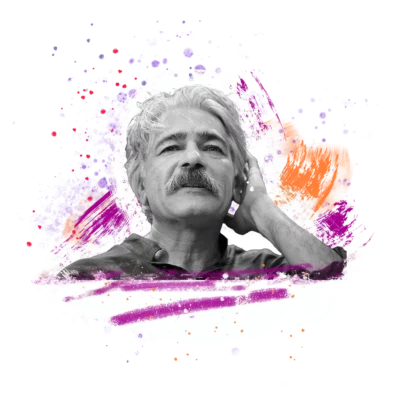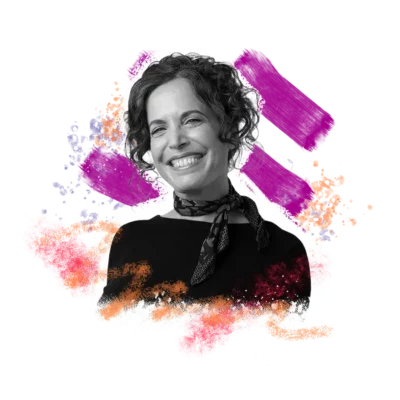Replenish your sense of meaning
Musician Kayhan Kalhor shares the story of composing and performing “Silent City,” his epic 25-minute piece for the kamancheh (Persian spiked fiddle) and ensemble. It’s a specific story about writing music to memorialize a devastating event, the massacre of innocents in Halabja, Iraq. But the takeaway is universal: When life feels too much to bear, create art that means something — for yourself and for others. As Kayhan takes us on the journey of creating “Silent City,” you’ll hear him find ways to bear witness to tragedy — and also celebrate the life that comes after. You’ll also hear how music-making, for him, is an ongoing quest for beauty, humanity, and meaning.

Transcript
Table of Contents:
- Chapter 1: When it means something
- Chapter 2: Like breathing
- Chapter 3: Playing my instrument
- Chapter 4: The unacceptable
- Chapter 5: The mission
- Chapter 6: East meets West
- Chapter 7: A dialogue
- Chapter 8: Composing “Silent City”
- Chapter 9: The first rehearsal
- Chapter 10: The concerts close to home
- Chapter 11: What “Silent City” means to me now
Transcript:
Replenish your sense of meaning

Chapter 1: When it means something
KAYHAN KALHOR: One of my favorite places on earth is under the dome of Shah Mosque in Isfahan, Iran. It’s a 15th-century mosque placed in a huge square. If I can condense all of Iran in one place, that would be the place, surrounded by all this history, culture, all of the glory of that old times, memories of my childhood, and the energy that those people put in this monument. Everything’s just right. The amount of artistry, the harmony, colors, the thoughtfulness, the detail, little pieces of ceramic that covers the dome inside and outside.
The sonic effect that that huge dome is creating: People say that if you say something there, it’s going to be repeated for seven times. And this is one of the wonders in architecture, in acoustics. Under the dome of that mosque is just magic. There’s so much beauty that one cannot digest in a minute or two or an hour.
The ridiculous world that we live in, people suffering, wars, ignorance, racial differences, hatred, sometimes you just feel that you cannot cope with that. It’s too much.
Whenever I feel that I have to renew my energy, I just drive to Isfahan and just stop under that dome and stare at it and find that, oh, these people managed to leave behind something extraordinary that tells you this world is a beautiful place.
I think that’s the highest point of creating an art. If something you do becomes very precious and means something special to someone else in this world, I think I live for that.
JUNE COHEN: That’s musician Kayhan Kalhor. And he’s about to tell us the story of composing and performing “Silent City.”
It’s a specific story about writing music to memorialize a devastating event. But the takeaway is universal: When life feels too much to bear, create art that means something — for yourself and for others.
As Kayhan takes us on the journey of creating “Silent City,” you’ll hear him find ways to bear witness to tragedy — and also celebrate the life that comes after. You’ll also hear how music-making, for him, is an ongoing quest for beauty, humanity, and meaning.
And here’s what you should know about Kayhan and “Silent City.” Kayhan is a virtuoso at the kamancheh, an instrument that’s also known as the Persian spiked fiddle. It’s played sitting down, and held like a cello. Kayhan is one of the world’s most renowned kamancheh players. We won’t have time to hear his entire personal story in this episode, but it feels important to know: Kayhan left his home in Tehran at 17, both to study as a musician and to escape the growing unrest that would lead to the Iranian revolution. He walked more than 2,500 miles over land to study in Rome. A few years later, his parents and brother were killed in a missile strike.
If you listened to our episode with Yo-Yo Ma, you heard Kayhan mentioned as a founding member of the Silk Road Ensemble. It was with Silkroad that Kayhan first developed “Silent City.”
“Silent City” is an instrumental, improvised piece composed for string quartet and kamancheh. It commemorates the 1988 massacre in the Kurdistan city of Halabja, where Saddam Hussein ordered a chemical weapons attack against his own people.
I’m your host June Cohen, and on this episode, you’ll hear original music composed for piano and marimba. In Chapter 3, you’ll hear Kayhan himself playing the kamancheh. For visuals while you’re listening, go to sparkandfire.com/silentcity.
[THEME MUSIC]
Chapter 2: Like breathing
How do you draw deep meaning from your craft? You live with it so closely, it becomes part of you.
KAYHAN KALHOR: I was five when my brother bought this santur, this hammered dulcimer. It’s a big instrument. The most popular version has 72 strings. So it’s very resonant. When he bought that instrument and brought it home, it was like I found my match. When my school was closed, I just ran home really fast. The distance was like 20 minutes. I had to do it in like five to play that instrument and just shower my soul with that sound. The freedom that I felt as a child, when I played that instrument, I didn’t know how to play it, but I just made it sound. That was my first introduction to music and to musical beauty. Then later on, other sounds became important.
When you live with music long enough, you don’t have to think that you’re a musician. It just becomes a part of your life without you knowing it. It becomes like breathing. You don’t have to practice to think of music. You sleep with music. You wake up with music, in your mind, in your body. It’s just there. There is no escape from music when you do music and that’s your life. It just becomes you. When I play in that special zone, I don’t know where that is. It’s the person who’s playing the instrument over there, but even I don’t know him. I’m just above, watching that instrument being played.
Chapter 3: Playing my instrument
KAYHAN KALHOR: I play the Persian kamancheh, which is the equivalent to Western violin, but much older than that. Kamancheh has been around for a few thousand years. It was born in Central Asia and traveled to different places, and then it took different forms in different musical cultures. A modern kamancheh has a round belly, like a bowl. It’s covered with a piece of animal skin. We use lambskin. And in Southeast Asia, they use snake or fish. Connected to the body of the instrument, there is a long neck, sort of a spike. So that’s why the ethnomusicologists call it the spike fiddle. You hold the fiddle on that pike, and you turn it. When you play the violin, in order to reach the different strings, you move your arm around. But in kamancheh, you move the instrument.
Chapter 4: The unacceptable
How do you respond to tragedy? Ask what your art is doing for humanity.
KAYHAN KALHOR: Chemical bombs kill people, but they don’t look different. There’s no blood, no houses went, the streets are there, the cars are there, but it’s as if everybody’s sleeping.
The innocence of those people. They didn’t do anything to deserve to be killed like that. It’s just being out of luck and being in the wrong place at the wrong time. That’s all.
That was the northeastern part of Iraq, the city of Halabja, with Kurdish population. This is ethnic cleansing, and tens of thousands got killed. How can a ruler do this to his own people?
I come from a Kurdish family as well. I come from Western Iran on the other side, a few hundred miles from the city. I just read about it. And I saw pictures. Everybody was trying to run away, and there was this father falling at the doorstep of his house trying to go home. And he was embracing a child. Probably in those few seconds that he had, he was trying to save the child.
That photo alone did it for me. I thought of it for days and days and days. This shouldn’t be a cause of human death. I don’t accept that.
This is happening every day around the world. And the worst part of it is that we’re becoming numb to this kind of news. Just don’t care about this anymore. And unfortunately, different governments, our government, your government, they decide to close their eyes, because it doesn’t bother them, and they’re friendly with that country at that moment. Or they just sold them those weapons to make money, and this is ridiculous. As a human, as someone who doesn’t benefit from another person’s death, we have to feel responsible.
So at those moments when you’re alone by yourself, when you’re not at your best, when you’re disappointed in life, in politicians, in people, you just question yourself. What am I doing? Am I doing something for humanity? Am I actually helping others? A doctor is doing that by bringing back people to help. Is a poet doing something for humanity? Is an author, a writer, or painter doing something for humanity? What am I doing in this life, just playing an instrument? It’s just a job, you know? What can I do for people?
JUNE COHEN: Did you recognize the tone in Kayhan’s voice when he says “I don’t accept that.” In the face of the unbearable, he’s determined to find meaning.
Chapter 5: The mission
How do you piece together a work that has meaning? Recruit talented friends to complete the puzzle.
KAYHAN KALHOR: I got introduced to Silk Road Project with Yo-Yo Ma, the well-known cellist. We lived together. We talked about music, about life. We were playing all this repertoire on our tours, Mongolian music, Chinese music, South American music, you name it.
There was this interest from those players to become familiar with Persian music. Music from where I come from. Music of Iran. And there was this flow of Persian-ness going on in the ensemble. Just like pieces of a puzzle just came together.
I thought: we can create something to keep that memory and to describe what happened to those people, innocent people, and make other people know about it. We all have a mission.
I asked my fellow musicians in the Silk Road to participate.
It was just an idea in my head. there was nothing on paper, that “Silent City,” for Halabja.
Chapter 6: East meets West
KAYHAN KALHOR: Our minds as Iranian or Persian musicians are totally different from the mind frame of a Western musician. It’s two different ways of seeing music and seeing art.
The basic difference is the scale and the intervals. In our music, you have intervals, they’re smaller than a half step. Or they’re slightly bigger than a half step, if that flat should be just a bit sharper than a flat. If you’re a Western musician, it gives you uncertainty on where you put your finger or how your instrument sounds. If your ears are trained to play a scale which is divided into 12 parts, divide it to 17 parts. That means a wider selection of notes, of moods, that makes a different flavor in that music.
I presented them two ways to play it. Either with flat notes and, you know, the scale in the Western way, or push the flats a little higher, and make it sound Persian. Of course, everyone wanted to do that. Why not? These are superb players. They play it beautifully. But it presents a lot of problems. Everyone sounded different. We had eight different notes. We’re out of tune. So we just played the scale. You have all these master musicians, they just play [sings a scale]. They just play the scale, and they choose to do this little simple thing to learn this principle.
They’re two different approaches. This is music, and the other one’s music — from Brazil, is music; from Africa, is music — but they all have different characteristics. These are the same children from the same family, but they’ve been raised elsewhere. But they all look the same, so you can recognize the resemblance.
Chapter 7: A dialogue
How do you create meaning when your collaborators work in different ways? Give them direction — and trust them to find their own way.
KAYHAN KALHOR: I always wanted to make a piece that most of it is improvised. Improvisation is the core of Persian music, but is not very stressed in Western musical culture. My musician friends in the West, they learn to read from the music all the time. They become dependent on that piece of paper, or now it’s an iPad, actually. It’s a relationship. So we don’t have that relationship. I can read music, but it’s not important to me. It’s not part of the deal. As if you can cook, but you don’t need a huge kitchen with a lot of equipment.
It’s not pure improvisation actually, because they have directions.
For example, when we reach this chaotic forte loud sound, and then one of us stops, everybody should stop. As if you’re supposed to meet me at a certain place at 2 o’clock, I don’t care how you reach there. You take the subway or you take the taxi, you fly, whatever. You take your bicycle. It’s like that, but you’re responsible to be there at 2 o’clock. They decide how they want to get there, to choose their own language to do that.
They could play in low register or on higher register, or harmonics. They can play [inaudible] or different kinds of combinations of bowing. It’s up to them.
We move to another section when we’re responsible to echo each other and to answer each other to create this dialogue between our instruments. If I do [singing], you could do [singing]. You could do it sooner or later. You could do it on any note you want.
It’s like a white canvas that you put in front of everyone. They know about this sad event. They’re excellent musicians. They know what to do.
It’s nice to put some sort of responsibility on their shoulders. That’s what this piece does.
Chapter 8: Composing “Silent City”
How do you create meaning from unbearable loss? Acknowledge the darkness. Then create space for the light.
KAYHAN KALHOR: I saw it backwards. I started from the end of what happens. It’s the aftermath. It starts from a soft sound. There is stillness, there is darkness. And then these long notes can change any time, anywhere. And then the sound grows and the instruments move higher in the register that they play. And this little stillness, it becomes chaotic loudness. Then it goes away again.
And then you hear echoes of life. Is there anyone out there? Da, da, da, da. You’re just looking for someone else.
Because when you howl, you make a sound. If you hear another sound, that helps you to understand that you’re not alone.
Whomever is there, life, space, sound, animals, vegetation, as if these little beings, somewhere in space, they’re trying to find themselves, as if: What happened? Are we still there? Am I still alive? Let’s see if my neighbor is still alive. We go on from here.
These pieces of life, they find each other. And to try to count how many people are there — there is one of them, and then there’s another one, you see a lot of them, a lot of beings are alive. So you hear a lot of sounds that found each other, and they have this chaotic dialogue. It changes to some fast movement, fast talking, da, da, da, da, da, da. They all try to communicate. Imagine you are there, you are at a place where there is no food. And suddenly, a UN truck brings food, and people just pour there: “Give it to me, give it to me.” It is like that. It’s finding your place and wanting something to live on and continue your life. It almost becomes chaotic. And that’s what there is there, it’s chaos.
After that, there is this stillness again. Okay. We want to be alive. We choose to be alive, and we put that behind. And there is this solo kamancheh. It acknowledges the devastating event. It mourns with it, but invites everyone to continue to go on. This is not the end of life, and we’re going to live.
And then there is this march, a funeral march actually, after all this chaos, all this dialogue that didn’t have a direction. This part is notated with harmony, with definition. Everybody knows what note they’re playing, and it’s a conventional piece of music. Order comes back.
When the march is over, I wanted to end the piece with life and with happiness.
There is human stupidity. There is sadness. There is all this cold-blooded killing going on. But the city is there, people still live there, their sons, their daughters, their family, and there is life being recycled. Human lives might be taken, but there’s some others who take the torch and continue. People who stay behind, they’re trying to continue the legacy of the ones who are gone. There is always life at the end. Human beings find a way to be alive. And this is how the world is.
JUNE COHEN: Did you notice how Kayhan approached telling the story of “Silent City”? He said, “I saw it backwards.” As he composed, he starts with the quiet stillness after the attack, and the way the city comes back to life. It’s a technique any of us can use on any project with meaning: What would happen if you start at the end?
Chapter 9: The first rehearsal
KAYHAN KALHOR: The very first time we were trying to rehearse this piece, there were eight string players, and they said, “Well, let’s play from bar 105 on.” I said, “No, no, no, no, no. Please start from the beginning.” They could put the pieces together without seeing the whole picture; they could do a certain piece outside of that structure, but I’m not able to do the same thing. I can’t understand what went on before. I have to listen to everything from the beginning to see if the process goes okay, and the time changes, the tempo changes happen organically in the place that they should.
To make an arc, you have to see the structure as an architect. Where the beginning is and the end is. You have to imagine the whole structure.
It doesn’t matter if it’s a long piece or short piece. No matter how big that picture is, I want to be able to see it all. But the other side, you could actually think of things as partial pieces. I try to imagine being capable of doing that, playing in pieces, thinking of a part of a piece. And they try to see my picture as well, or my side of the story as well, to see the bigger picture, to see the whole structure.
Sometimes in absence of a few musicians of ours, we had to play it with other musicians, with a lot of students, with orchestral musicians, or we tried to play it with musicians from other countries, musicians that don’t know how this process takes place. And we found this way to play it and to teach it. We found a language that communicated with other musicians that don’t know how this process takes place. It became very organic. We just go back and forth and exchange vibes. We didn’t decide: How long should this note be? or How long should that note be? They just found themselves. And then all the pieces that we tried to put together, or the places that we were trying to go, they all presented themselves. People showed us what to do. It helped all of us to be better creators, better musicians, and better teachers, to give us another dimension of what we’re able to do.
Chapter 10: The concerts close to home
How can you tell if your work has meaning? Bring it to the people who need it most.
KAYHAN KALHOR: I always wanted to perform this piece in Iran. People who just listened to the recording of it, they saw clips on YouTube or whatever, they knew of it, but they haven’t actually heard it live. There is nothing like listening to a piece live at a concert.
This piece is meant to be performed on stage.
The most important reason for me to perform is to be satisfied, myself, to feel good after I’m finished. I strongly believe that if I do that, if I really feel good about what I produced on stage, the audience will love it as well. I don’t think that I have to please. I’m a performer. I’m supposed to perform and translate all of my thoughts into music. I’m a musician, so that’s all I could do, and I hope that people like it.
Last year, I played it in Iran for 75 nights. I just wanted to do this for the people who were there, who died in that devastating event. To put it in a simple way, it just went back home. As we kept playing it more and more, we understood what effect it can have on people. The reaction of the audience was extraordinary. People cried with it, just felt it, but what really moved me was people from Halabja coming to the concert and to especially listen to this piece that was written for them and for their parents, for their families that they lost. There was this guy that came to the concert. He said, “Well, I’m from Halabja, and I just came from Iraq, and I lost my parents there. Thank you for writing this piece.”
Chapter 11: What “Silent City” means to me now
KAYHAN KALHOR: My life before that piece and after that piece is not the same. That’s the moment that I’m satisfied with what I do in life, and I can say I’m doing something effective for humanity as a musician.
When you’re an artist, sometimes you just create an art, and it’s there. It’s a beautiful piece of music, a painting, whatever, even a book, but it becomes more precious if it means something to others as well.
JUNE COHEN: I want to thank Kayhan for sharing the story of this creative journey with us. And I want to thank you for listening. I hope you found things in it you can bring into your own creative work.
Maybe it’s the way Kayhan drives for hours to visit the Shah mosque in Iran when he needs to refuel his own sense of meaning.
Or it might be in Kayhan’s original response when he first saw that photo of the father protecting his son: in the face of that unbearable tragedy, he knew he had to find meaning. Or, it might be how the true meaning of “Silent City” becomes clear to Kayhan only when it finally meets its intended audience — and helps the victims and their families process some part of their pain.

